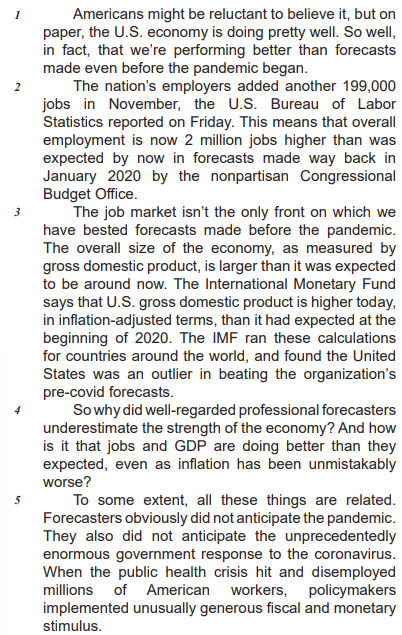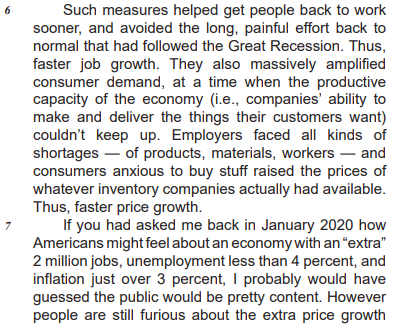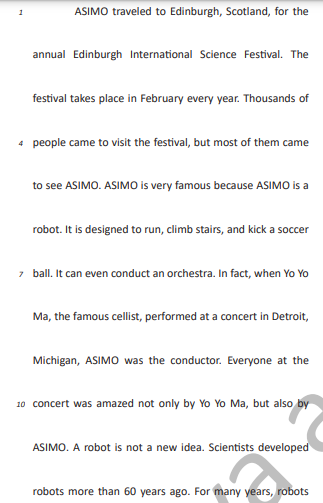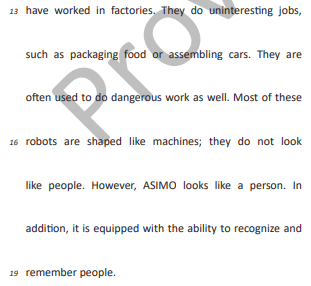Questões de Concurso
Sobre inglês nível médio
Foram encontradas 1.642 questões
Resolva questões gratuitamente!
Junte-se a mais de 4 milhões de concurseiros!
The word in bold is associated with the idea of:
Text 18A3-I
The roar of a waterfall suggests the power of water. Rampaging floodwaters can uproot strong trees and twist railroad tracks. When the power of water is harnessed, however, it can do useful work for humans.
Since ancient times, people have put the energy in the flow of water to work. They first made water work for them with the waterwheel, a wheel with paddles around its rim. Flowing water rotated the waterwheel, which in turn ran machinery that was linked to it. Today, new kinds of waterwheels — turbines — spin generators that produce electricity. Electricity from water-turned generators is known as hydroelectricity.
By building a dam across a river, the natural upstream water level is elevated and a difference in head is created that can be used to drive turbines and generate electricity. A large upstream reservoir may balance seasonal water flow; rain or melted snow can be stored in the reservoir during the wet season to provide electricity during dry seasons.
Waterpower is distributed unevenly among the continents and nations of the world. Europe and North America have developed much of their waterpower. Asia, South America, and Africa have abundant waterpower potential, but while countries such as China and Brazil have become leading hydroelectric producers, much of the waterpower resource on those continents remains undeveloped.
Elizabeth Lachner. Hydroelectricity. Rosen Publishing Group, 2018 (adapted).
Text 18A3-I
The roar of a waterfall suggests the power of water. Rampaging floodwaters can uproot strong trees and twist railroad tracks. When the power of water is harnessed, however, it can do useful work for humans.
Since ancient times, people have put the energy in the flow of water to work. They first made water work for them with the waterwheel, a wheel with paddles around its rim. Flowing water rotated the waterwheel, which in turn ran machinery that was linked to it. Today, new kinds of waterwheels — turbines — spin generators that produce electricity. Electricity from water-turned generators is known as hydroelectricity.
By building a dam across a river, the natural upstream water level is elevated and a difference in head is created that can be used to drive turbines and generate electricity. A large upstream reservoir may balance seasonal water flow; rain or melted snow can be stored in the reservoir during the wet season to provide electricity during dry seasons.
Waterpower is distributed unevenly among the continents and nations of the world. Europe and North America have developed much of their waterpower. Asia, South America, and Africa have abundant waterpower potential, but while countries such as China and Brazil have become leading hydroelectric producers, much of the waterpower resource on those continents remains undeveloped.
Elizabeth Lachner. Hydroelectricity. Rosen Publishing Group, 2018 (adapted).
Text 18A3-I
The roar of a waterfall suggests the power of water. Rampaging floodwaters can uproot strong trees and twist railroad tracks. When the power of water is harnessed, however, it can do useful work for humans.
Since ancient times, people have put the energy in the flow of water to work. They first made water work for them with the waterwheel, a wheel with paddles around its rim. Flowing water rotated the waterwheel, which in turn ran machinery that was linked to it. Today, new kinds of waterwheels — turbines — spin generators that produce electricity. Electricity from water-turned generators is known as hydroelectricity.
By building a dam across a river, the natural upstream water level is elevated and a difference in head is created that can be used to drive turbines and generate electricity. A large upstream reservoir may balance seasonal water flow; rain or melted snow can be stored in the reservoir during the wet season to provide electricity during dry seasons.
Waterpower is distributed unevenly among the continents and nations of the world. Europe and North America have developed much of their waterpower. Asia, South America, and Africa have abundant waterpower potential, but while countries such as China and Brazil have become leading hydroelectric producers, much of the waterpower resource on those continents remains undeveloped.
Elizabeth Lachner. Hydroelectricity. Rosen Publishing Group, 2018 (adapted).

That affirmation is correctly translated into English in

The expression the world’s sixth-largest economy from that statement is correctly translated into Portuguese in












The expression well-regarded professional forecasters can be rewritten, with no change in meaning, as



Concerning the text, judge the item.
The terms “However” (line 17) and “In addition” (lines
17 and 18) can be correctly replaced by Hence and
Therefore, respectively
Concerning the text, judge the item.
The adverb “often” (line 15) indicates something that
happens not very frequently.
Concerning the text, judge the item.
The subject pronoun in the sentence
“It is designed to run, climb stairs, and
kick a soccer ball” (lines 6 and 7) refers
to ASIMO.
Concerning the text, judge the item.
The expression “such as” (line 14) is used to introduce
an example or a list of examples.
Concerning the text, judge the item.
The term “they” (line 13) refers to robots from the
previous sentence.
Concerning the text, judge the item.
Yo Yo Ma is a famous robot that played in a concert in
Detroit conducted by ASIMO.
Concerning the text, judge the item.
ASIMO can do things related to sports and music. It
can also recognize a human.
Concerning the text, judge the item.
Everyone goes to the festival only to see ASIMO.

